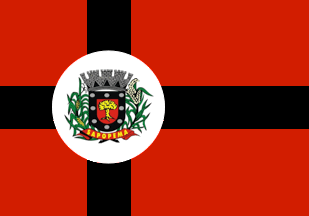 image by Ivan Sache, 9 February 2022
image by Ivan Sache, 9 February 2022
Last modified: 2022-03-05 by ian macdonald
Keywords: parana | sapopema |
Links: FOTW homepage |
search |
disclaimer and copyright |
write us |
mirrors
 image by Ivan Sache, 9 February 2022
image by Ivan Sache, 9 February 2022
The municipality of Sapopema (6,751 inhabitants in 2018; 67,761 ha) is
located 320 km north-west of Curitiba. The municipality is composed of the
districts of Sapopema (seat), Vida Nova (established by State Law No. 7,523
promulgated on 22 September 1984) and Lambari (established by State Law No.
5,642 promulgated on 27 October 1984)
Sapopema was established in 1936 by
Engineer Antônio Martins Paraná, who built a house near a sapopema tree,
Sloanea hirsuta (Schott) Planch. ex Benth.; quite uncommon in the region,
the tree was used as a landmark and therefore not uprooted during the
establishment of the old road connecting Curitiba to Londrina.
The district
of Sapopema was established by State Law No. 790 promulgated on 14 November
1951, to be elevated a municipality, separating from Curiúva, by State Law No.
4,245 promulgated on 22 September 1960. The municipality was inaugurated on 28
October 1961.
https://www.sapopema.pr.gov.br/
Municipal website
The flag and
arms of Sapopema are prescribed by Municipal Law No. 133 promulgated on 27 June
1980.
The flag is red with a black cross skewed to the hoist and
superimposed by a white disc inscribing the municipal coat of arms.
The black
color means strength, constancy, prudence, simplicity, wisdom, science,
moderation, honesty and plenty. The color gules (red) represents struggle,
courage, audacity, the way to fight for the progress of the municipality.
The Iberian shield was used in Portugal at the time of the discovery of
Brazil. The color gules (red) represents struggle, courage, audacity, the way to
fight for the progress of the municipality. The tree signifies fertility and
faithfulness. Or indicates wealth, nobility, glory, builds progress and
generates prosperity in the municipality. Of the eight towers, only five are
represented on the coat of arms, as the symbol of political emancipation; the
black open doors emphasize the hospitality of Sapopema's people. Maize and rice
emphasize the fertility of Sapopema's soil and the importance of these products
for the town.
https://www.sapopema.pr.gov.br/bandeira
Municipal website
Ivan Sache, 9 February 2022